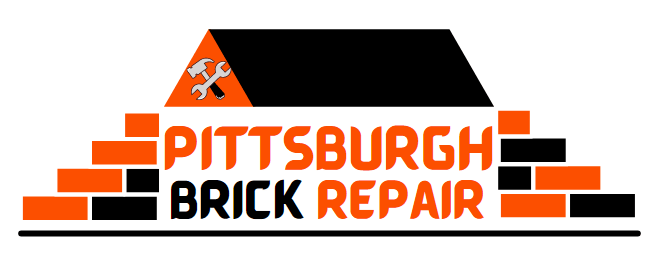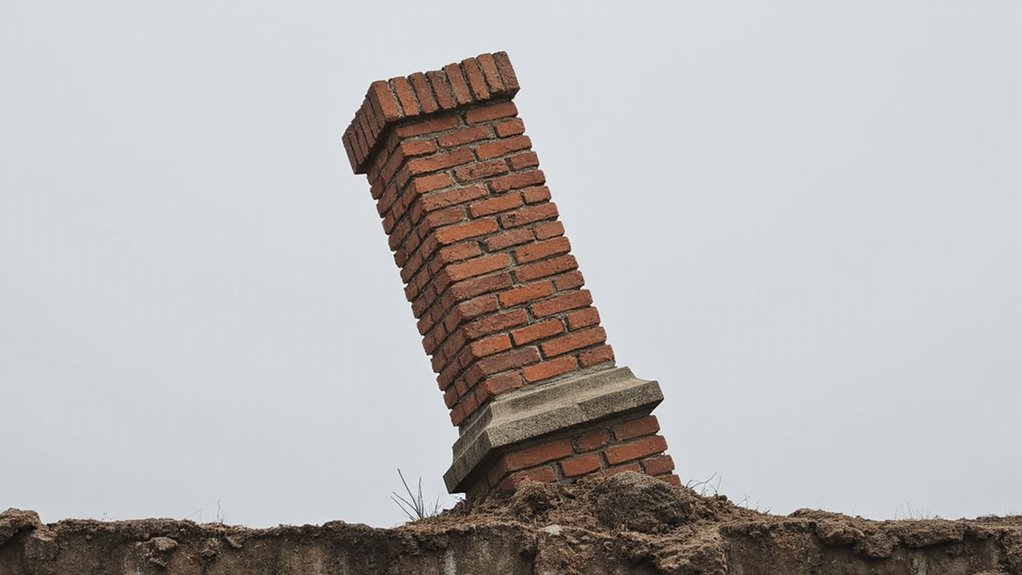Unearthing a leaning chimney can send shivers down any homeowner’s spine. It’s not just an eyesore—it’s a potential structural warning sign that something’s seriously wrong beneath the surface. Your chimney’s tilt might signal hidden issues like unstable ground, water damage, or foundational problems. Before you panic, comprehending why it’s happening can help you take the right steps to protect your home’s safety and integrity.
Foundation Settlement and Soil Conditions
When your chimney starts to lean, foundation settlement might be the culprit lurking beneath the surface. Unstable soil composition and inadequate soil compaction can cause your home’s foundation to shift, creating uneven support for heavy structures like chimneys.
You might notice the lean developing gradually, which signals underlying ground movement. Rocky, clay-heavy, or poorly prepared soil can compromise your chimney’s stability, leading to potentially serious structural issues.
If you’re experiencing this problem, don’t panic – professional chimney repair services in Pittsburgh can provide expert assessment to pinpoint the exact cause and recommend targeted solutions to stabilize your chimney and prevent further damage.
Poor Initial Construction Techniques
Because poor initial construction techniques can compromise your chimney’s structural integrity, many homeowners unknowingly inherit leaning problems from substandard building practices. Improper framing techniques and inadequate bracing design can create serious structural vulnerabilities that gradually cause your chimney to tilt. Mortar deterioration caused by wind and moisture can further weaken the chimney’s structural support, exacerbating existing construction flaws.
Skilled masons understand how critical precise alignment and foundational support are during initial construction. Your chimney’s stability depends on expert craftsmanship, precise measurements, and strategic reinforcement. By recognizing these potential construction flaws early, you can prevent long-term structural issues and protect your home’s safety and aesthetic appeal.
Water Damage and Moisture Intrusion
Something as seemingly minor as water can wreak havoc on your chimney’s structural stability, causing serious leaning issues over time. Moisture intrusion from roof leaks and ice dam formation can slowly deteriorate your chimney’s foundation and surrounding masonry.
As water seeps into tiny cracks, it expands and contracts with temperature changes, gradually weakening the structure. This constant stress causes bricks to shift, mortar to crumble, and your chimney to lean precariously.
Without proper maintenance and timely repairs, water damage can compromise your chimney’s integrity, potentially leading to expensive structural repairs or complete replacement.
Age-Related Structural Deterioration
Every chimney inevitably experiences structural wear and aging that can contribute to its gradual lean over decades of exposure. Your chimney’s materials naturally deteriorate through weathering patterns and seasonal temperature changes, causing subtle shifts in its foundational integrity.
As mortar joints crumble and bricks become brittle, the structure’s stability progressively weakens. These incremental changes might seem imperceptible at first, but they conclusively compromise your chimney’s vertical alignment. Understanding these age-related challenges helps you recognize when professional intervention becomes necessary, ensuring your home’s safety and preventing more extensive structural damage.
Ground Shifting and Earthquake Impact
How dramatically can the earth beneath your home influence your chimney’s stability? Ground shifting can cause serious foundation problems that lead to chimney leaning.
Frost heaving during winter months causes soil to expand and contract, creating uneven pressure beneath your structure. Heavy snowfall can further stress already unstable ground, potentially exacerbating existing foundation weaknesses.
Seismic activity, even minor earthquakes, might trigger subtle ground movements that gradually destabilize your chimney’s base. Understanding these geological factors helps you recognize warning signs early and take preventative measures to protect your home’s structural integrity.
Tree Root Interference
Nearby trees can silently undermine your chimney’s stability through their expansive root systems. As plant growth continues, roots seek moisture and nutrients, potentially causing significant foundation damage.
The natural cycle of freezing and thawing amplifies this stress, pushing soil and roots against your chimney’s base. You mightn’t realize the danger until visible leaning occurs, indicating underlying structural compromise.
Tree roots can extend far beyond the tree’s canopy, creating unexpected pressure on your home’s foundation. Understanding this risk helps you proactively monitor and address potential chimney instability before costly repairs become necessary.
Masonry and Mortar Degradation
When moisture seeps into your chimney’s masonry, it can trigger a slow but destructive process of mortar degradation that compromises your chimney’s structural integrity. Brick drying issues and improper mortar mixing accelerate this breakdown, causing your chimney to weaken and potentially lean.
As water penetrates the masonry, it erodes the mortar joints, creating gaps and reducing the structural support. This degradation can lead to serious stability problems, making your chimney vulnerable to shifting and structural failure.
Regular inspections and timely repairs can help prevent these issues and protect your home’s safety.
Professional Repair and Stabilization Methods
Professionals can quickly tackle leaning chimney issues through specialized stabilization techniques that restore structural integrity and prevent further damage. Chimney stabilization strategies often involve structural reinforcement options like steel bracing, foundation underpinning, and targeted masonry repairs.
You’ll want experts who can assess your specific situation and recommend the most effective solution. They might use helical piers, carbon fiber straps, or specialized grout injections to realign and support your chimney’s structure. These professional methods not only fix the current lean but also prevent future movement, giving you peace of mind and protecting your home’s safety.
Frequently Asked Questions
Can a Leaning Chimney Collapse and Pose a Safety Risk?
You’ve got structural stability concerns if your chimney leans. It could collapse, presenting serious safety hazards that threaten your home’s integrity and your family’s well-being.
How Much Does Professional Chimney Straightening Typically Cost?
You’ll likely spend $500-$2,500 for professional chimney straightening, depending on damage severity. Get multiple quotes from certified contractors to compare prices and guarantee a precise, safe repair.
Is a Slight Chimney Lean Always a Serious Structural Problem?
A slight chimney lean isn’t always critical. If it’s minimal and gradual, you’ve likely got time to consult professionals before serious structural damage occurs. Monitor the movement and seek expert assessment.
Will Homeowner’s Insurance Cover Repairs for a Leaning Chimney?
Your coverage depends on the cause. If the lean results from sudden damage, you’ll likely be protected. But policy exclusions and insurance coverage limits might restrict your claim, so check your specific policy carefully.
Can I Fix a Leaning Chimney by Myself as a DIY Project?
You shouldn’t attempt a DIY chimney repair without professional competence. Inspect chimney stability carefully and evaluate cost effectiveness – complex structural issues often require skilled contractors to guarantee safe, proper restoration.

